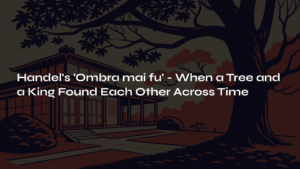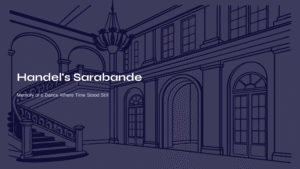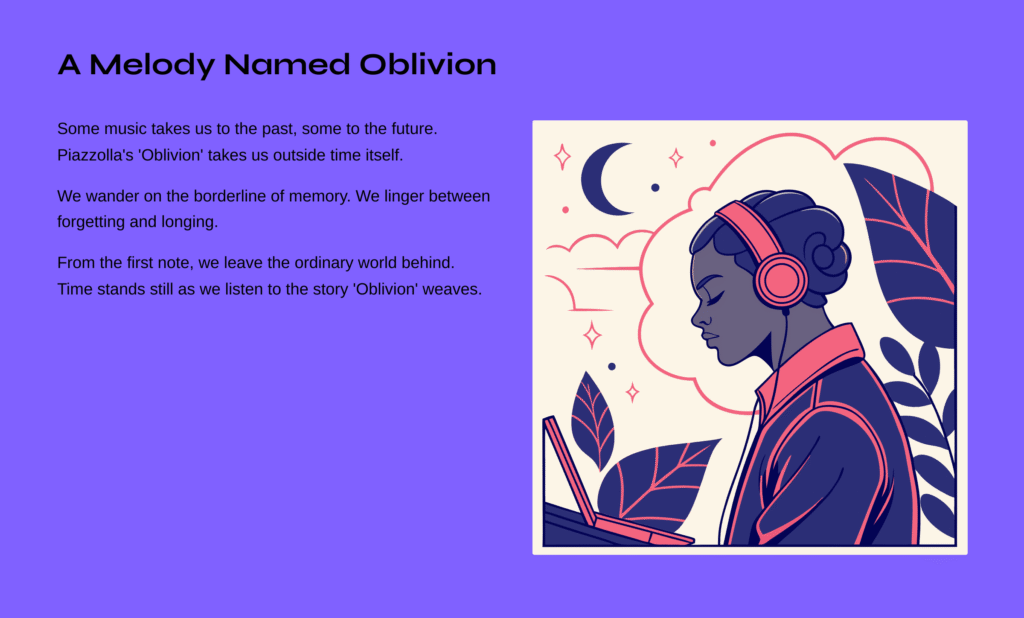
A Melody Named Oblivion
Some music takes us to the past, some makes us dream of the future. But Piazzolla’s ‘Oblivion’ is different. This piece takes us outside of time itself. Like wandering on the borderline of memory, it makes us linger somewhere between forgetting and longing.
From the moment the first note resonates, we know this is not a simple tango. When the melancholic, sigh-like sound of the bandoneon flows through the air, we have already left the ordinary world behind. In the illusion of time standing still, we find ourselves listening to the story that ‘Oblivion’ weaves.
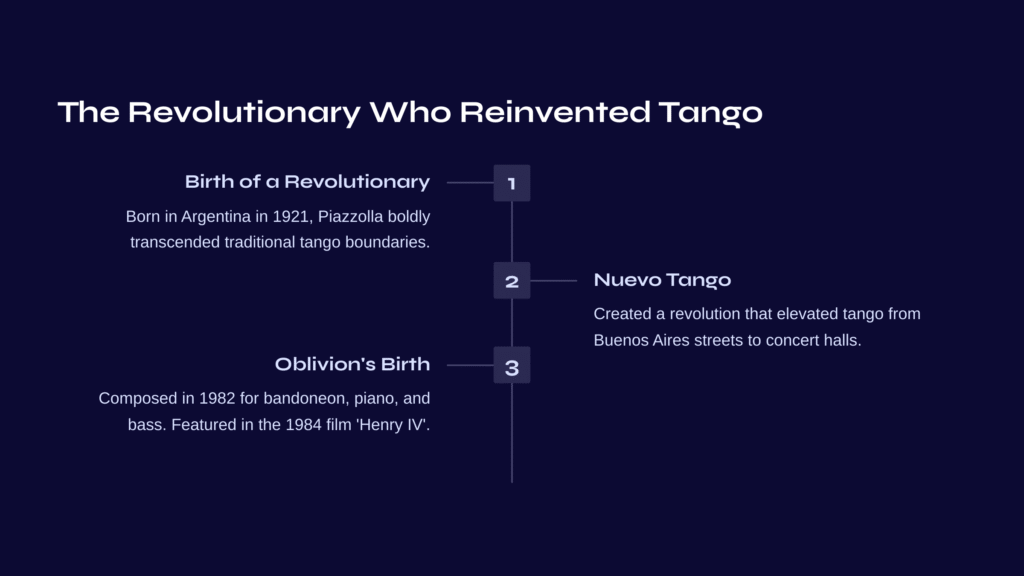
The Revolutionary Who Reinvented Tango
Astor Piazzolla was born in Argentina in 1921, a musician who boldly transcended the boundaries of traditional tango. His creation of ‘Nuevo Tango’ was a revolution that elevated tango from the night streets of Buenos Aires to the concert hall. At the intersection of classical music’s precision, jazz’s freedom, and tango’s passion, his unique musical language was born.
Composed in 1982, ‘Oblivion’ was originally written for bandoneon, piano, and bass. But the true power of this piece lay not in its instrumentation. As the title ‘Oblivion’ suggests, it lay in its ability to musically embody the bittersweet nostalgia for things that are disappearing. After being featured in the 1984 film ‘Henry IV,’ this piece became known worldwide and has since been reborn in countless arrangements and performance versions.
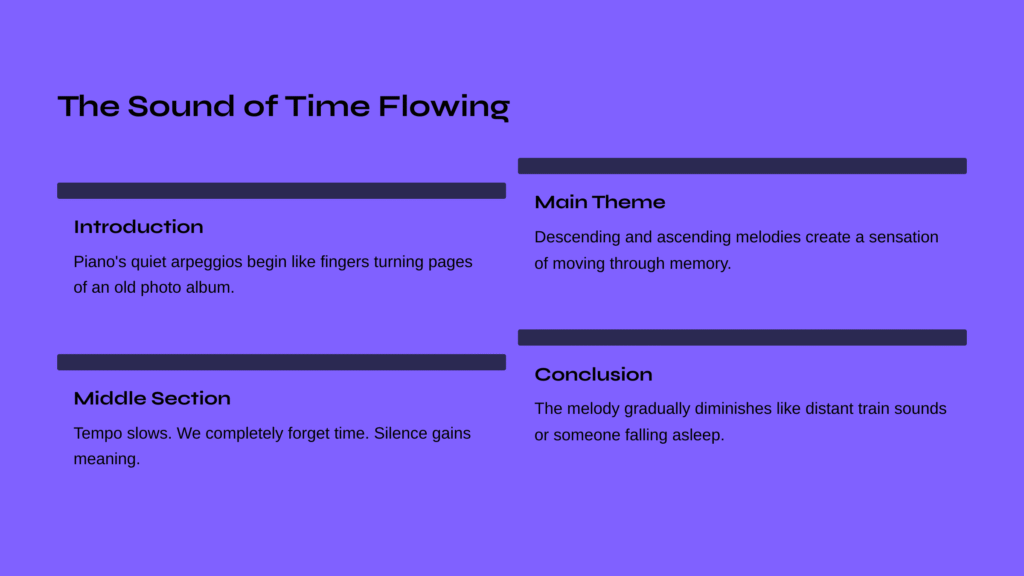
The Sound of Time Flowing
Introduction: At the Threshold of Memory
The piece begins with the piano’s quiet arpeggios. Like fingers carefully turning the pages of an old photo album, delicate and cautious. Above this, the bandoneon’s long melody slowly emerges. In this moment, we have already left behind the noise of daily life and entered the quiet space within.
The sound of the bandoneon is truly unique. This instrument, somewhere between a harmonica and an accordion, creates a resonance like a deep sigh. I understand why Piazzolla chose this instrument. No other instrument could be more suitable for expressing longing.
Main Theme: The Dance of Oblivion
When the full melody begins, we reach the heart of ‘Oblivion.’ Descending and ascending melodies intersect, creating a sensation like moving up and down through memory. This is not simple sadness. It contains mourning for what is lost while simultaneously embodying a mature resignation that accepts it.
The dialogue between piano and bandoneon reaches its climax here. Sometimes imitating each other, sometimes creating contrast, like a deep conversation between two people without words. The bass’s thick rhythm supports all of this firmly while maintaining tango’s identity.
Middle Section: A Moment When Time Stops
In the middle section of the piece, the tempo becomes even slower. Here we completely forget the flow of time. The melody becomes more concise, and the spaces between notes gain meaning. This silence is not empty but rather the moment that contains the most.
When I listen to this section, I always imagine Buenos Aires at twilight. That moment when the sunset tilts between buildings and the city’s noise briefly subsides. When everything is tinged with orange and time flows slowly like honey.
Recapitulation and Conclusion: Into the Afterglow
When the main theme returns, we have already become different people. The same melody, but it approaches us with different meaning than when we first heard it. This is the magic that good music possesses—making us discover something new within repetition.
At the end of the piece, the bandoneon’s melody gradually diminishes. Like the sound of a distant train, or like the breathing of someone falling asleep. And finally, silence arrives. But this silence is not an end but a beginning—the beginning of the afterglow that continues to resonate in our hearts even after the music ends.
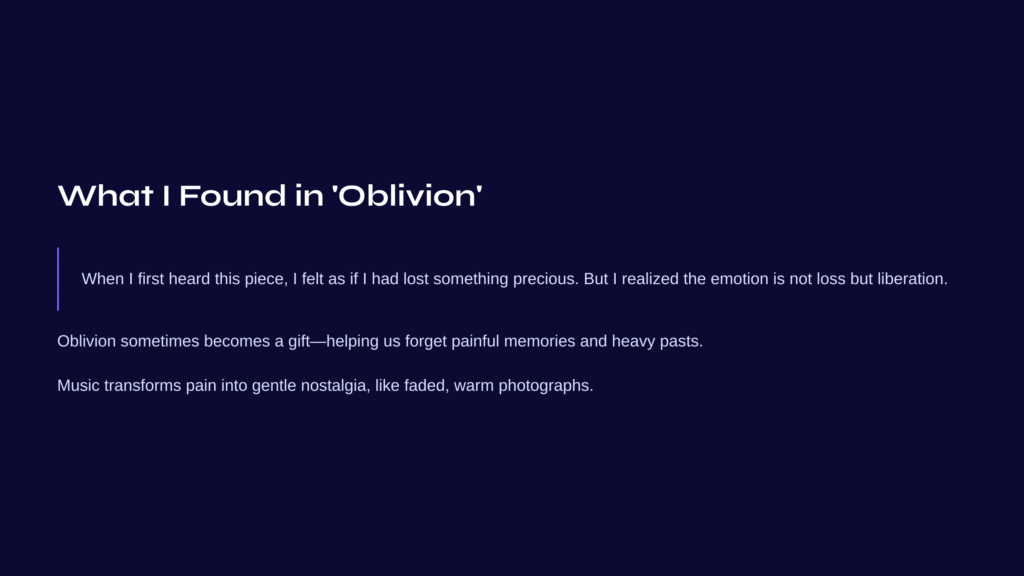
What I Found in ‘Oblivion’
When I first heard this piece, I felt as if I had lost something. I couldn’t specify what I had lost, but I definitely felt as if something precious had disappeared. However, as I listened to the piece repeatedly, I realized that the emotion this piece gives is not a sense of loss but a sense of liberation.
Oblivion sometimes becomes a gift—helping us forget memories that are too painful, pasts that are too heavy. Piazzolla seemed to know this. That’s why he titled this piece ‘Oblivion.’ That forgetting can sometimes be the most courageous choice.
While listening to music, I often recall certain moments from the past. But they no longer cause me pain. Instead, they transform into gentle nostalgia, becoming faded and warm like old photographs. This is the greatest gift that ‘Oblivion’ has given me.
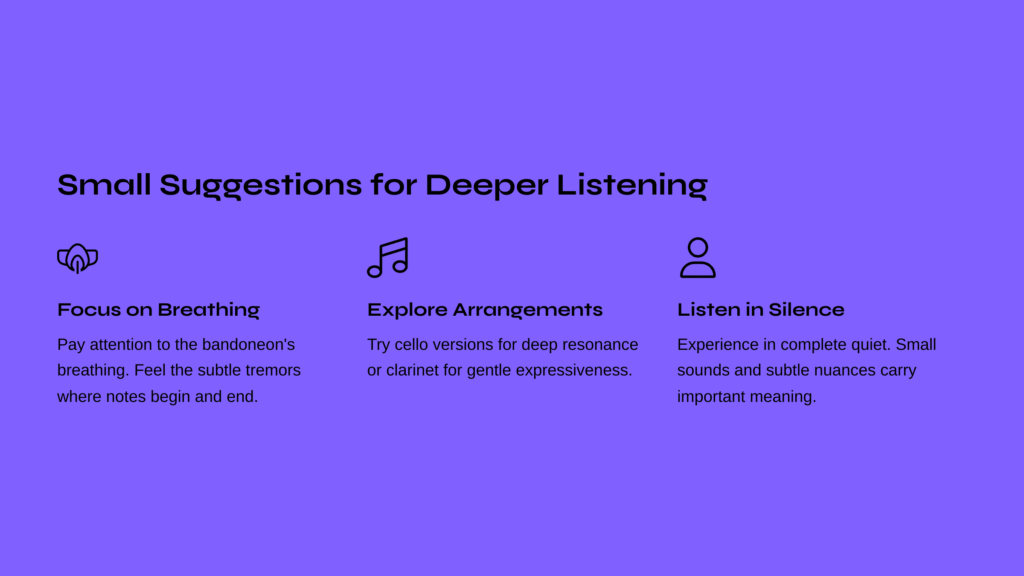
Small Suggestions for Deeper Listening
First Suggestion: Focus on the Bandoneon’s Breathing
When listening to ‘Oblivion,’ pay special attention to the bandoneon’s breathing. This instrument is directly connected to the performer’s breath, so the sound emerges as if a person is breathing. At the points where notes begin and end, feel those subtle tremors and reverberations. In that moment, you will be able to draw closer to the performer’s emotions.
Second Suggestion: Explore Various Arrangement Versions
After sufficiently listening to the original bandoneon version, try listening to arrangements for other instruments. In the cello version, you can feel the deep resonance characteristic of string instruments; in the clarinet version, the gentle expressiveness of woodwinds. By watching how each instrument interprets ‘Oblivion’ differently, you can discover the multilayered charm of this piece.
Third Suggestion: Listen in Complete Silence
If possible, listen to this piece in a completely quiet environment. With your smartphone silenced and all surrounding noise blocked out. ‘Oblivion’ is a piece where small sounds and subtle nuances carry important meaning. To not miss such details, you need an environment where you can focus entirely on the music.
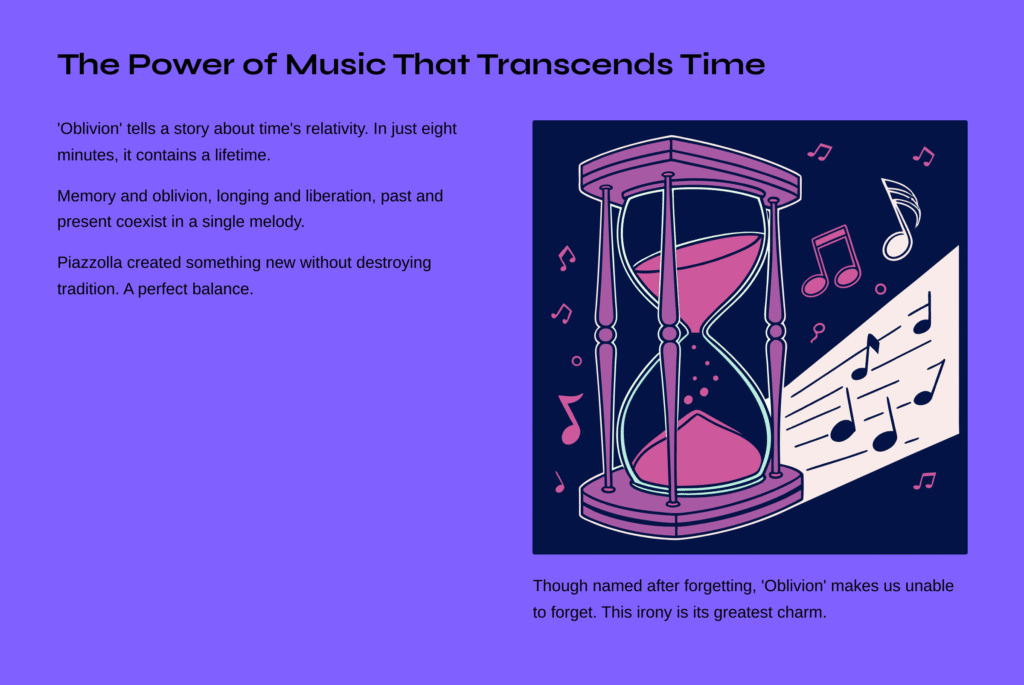
The Power of Music That Transcends Time
Ultimately, what ‘Oblivion’ tells us is a story about the relativity of time. Though it’s a short piece of just over eight minutes, it contains a lifetime within it. Memory and oblivion, longing and liberation, past and present coexist within a single melody.
Piazzolla transcended the boundaries of the tango genre while never losing its essence. Isn’t this the virtue of a true artist? Creating something new without destroying tradition. ‘Oblivion’ is the product of such perfect balance.
Even after the music ends, we still remain within the afterglow of that melody. This is the magic that good music possesses—making us continue to hear it even when it’s no longer audible, making it unforgettable as time passes, or rather, making it deepen as time goes by.
Thus, ‘Oblivion,’ while bearing the name of forgetting, actually makes us unable to forget anything. Perhaps this irony is the greatest charm this piece possesses.
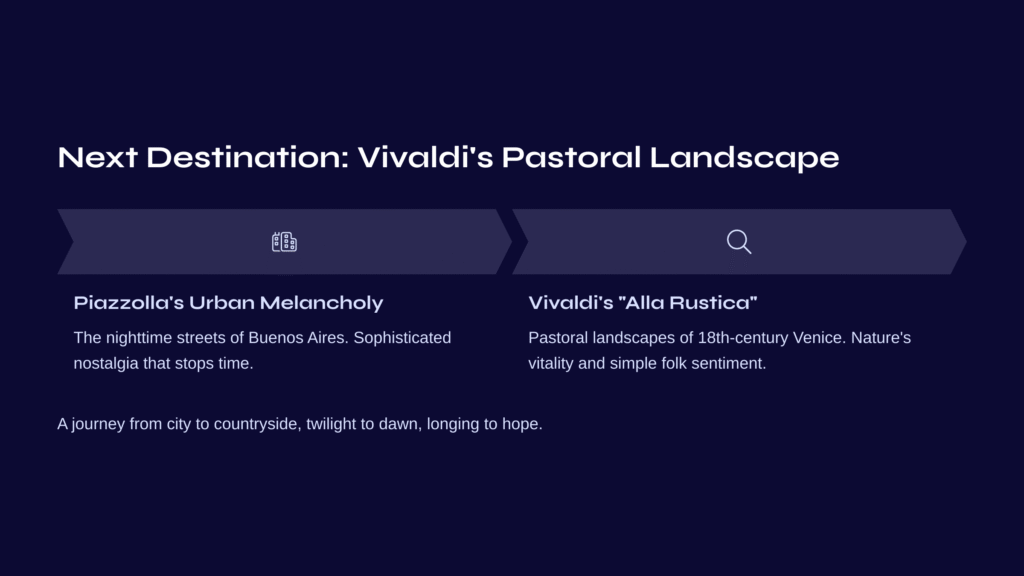
Next Destination: Vivaldi’s Pastoral Landscape
After being immersed in the urban melancholy and refined nostalgia of ‘Oblivion,’ how about journeying to a completely different world? Vivaldi’s “Concerto for Strings in G major, RV 151 ‘Alla Rustica'” exists on the opposite side from the nighttime streets of Buenos Aires that Piazzolla depicted.
“Alla Rustica” means “in a rustic style,” and this work musically depicts the pastoral landscapes imagined by 18th-century Venetian aristocrats. Instead of the weight of oblivion, it’s filled with the vitality of nature; instead of urban sophistication, it brims with the simple sentiment of folk songs.
If Piazzolla stopped time, Vivaldi returns time to nature’s rhythm. From the rooster’s crow at dawn to the cricket’s song at evening, this piece unfolds the cycle of a day through the dialogue of strings, leading us outside of daily life in a completely different way from ‘Oblivion.’ It will be a journey from city to countryside, from twilight to dawn, from longing to hope.

